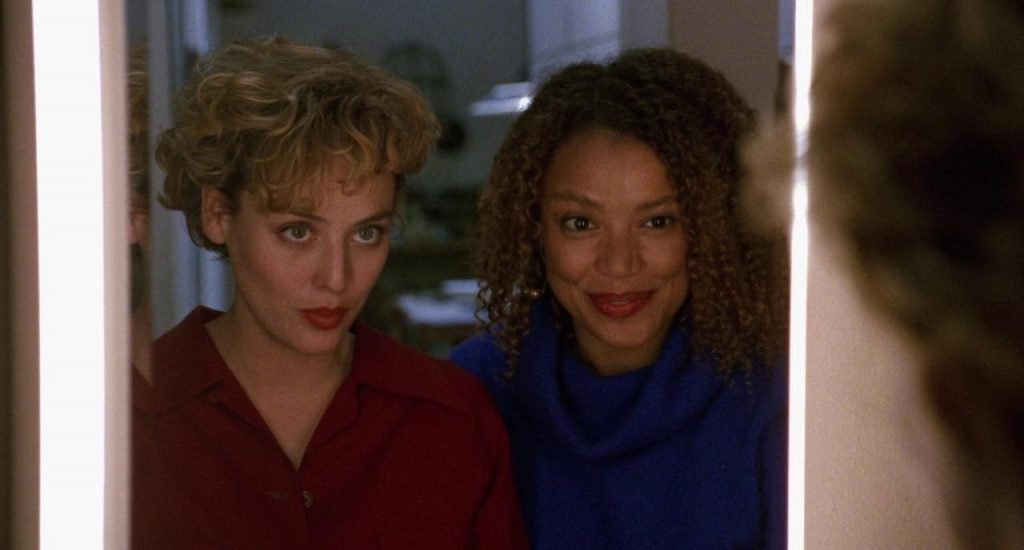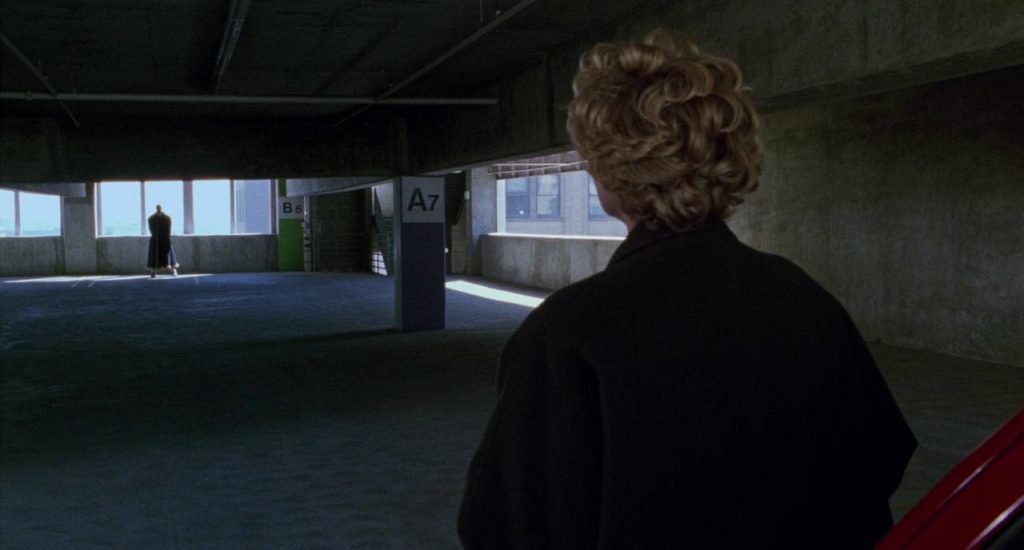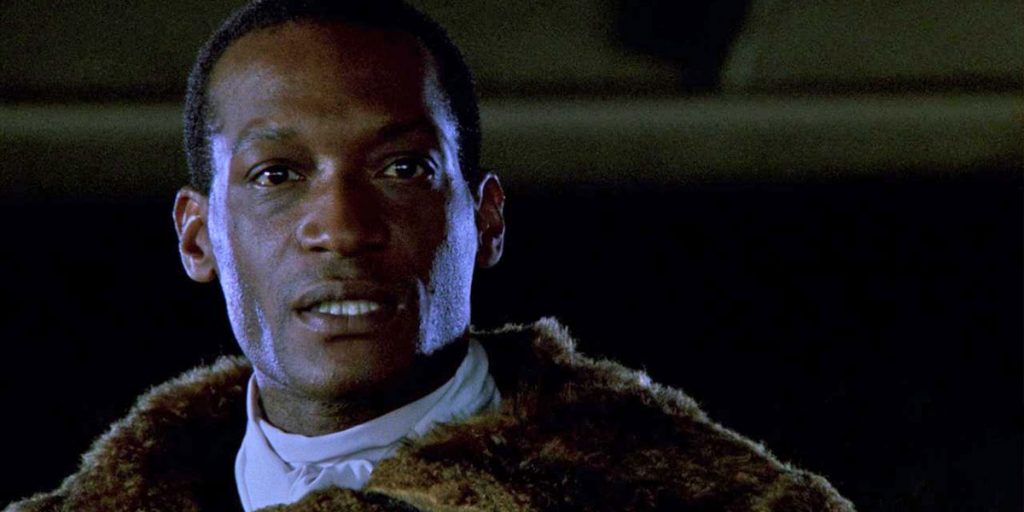Candyman’s commentary on race remains just as riveting as it was thirty years ago, and its mix of fantastical and familiar horrors haunts audiences to this day.
Though we have to wait three more months to see what chaos writer-director Nia DaCosta (Little Woods) and producer Jordan Peele (Get Out, Us) have cooked up for us with their Candyman reboot, we can take comfort in the fact that the frightening first installment in the franchise is currently only a click away on Netflix. For the second edition of “Flashback Films,” we shine our spotlight on Bernard Rose (Paperhouse, Immortal Beloved)’s 1992 original entry in the series, also titled Candyman, which follows a gung-ho graduate student named Helen (Vanessa Madsen, of Sideways and The Rainmaker) who works alongside her friend, Bernadette (Kasi Lemmons, most recently recognized for directing 2019’s Harriet), to investigate an unsettling urban legend that has spread through the slums of Chicago. This mysterious myth in question concerns a mutilated man (Tony Todd, of Platoon and Final Destination) with a hook for a hand who emerges into our world after his name is uttered into a mirror five times, at which point he promptly executes the individual who summoned him.
While Helen maintains that the fearsome folktale is no more than a convoluted coping mechanism for the (mostly African-American) citizens of this community to rationalize the real-life tragedies that take place each and every day, as she continues her case study, she comes to realize that there may be more truth to this terror than she ever imagined.
Right off the bat, some may take issue with the perceived “white savior” perspective present in the film, since we solely see the suffering of these Black Chicagoans through Helen’s white, middle-class worldview. However, Rose’s savvy script finds plenty of ways to counter these criticisms. For starters, as Helen sneaks around the slums in an effort to better understand Candyman’s customs, she is surprisingly self-aware of her higher social status, and she makes active attempts to assure others that she is not aiming to be “exploitative” in her examination of the community. Furthermore, Helen is continually called out by the Black residents of the housing project that she pokes through (one notes that “whites don’t never come through here, ‘cept to cause a problem”), which indicates that Rose was certainly cognizant of potentially unfavorable assessments and made it his intent to steer clear of such insensitivity in his screenplay.

The story even weaves in some admirably “ahead-of-its-time” analysis on the police force’s apathy towards Black neighborhoods; when Helen is attacked in this housing project by a gang leader adopting the “Candyman” moniker to spread fear and force others to do his bidding, she is rescued immediately and this man is swiftly put behind bars. After realizing that countless other assaults and/or murders in the projects have been reported prior to this incident and yet often went ignored, Helen states, “A white woman gets attacked and they lock the place down. Kind of shows their priorities, eh?”
However, Candyman most strongly subverts the “white savior” trope with its radical representation of the relationship between Helen and the horror himself. The two become inextricably (and irrevocably) linked as soon as Helen discovers the “real” Candyman’s history as a victim of race-related hatred. As the story goes, in the late 1800s, Candyman’s father gained acceptance from white society as a result of his profitable mass production of shoes during the Civil War, which allowed for Candyman himself to enter this community as well. An artistically gifted child, Candyman was often employed by wealthy white individuals and their families to paint portraits. Years later, Candyman fell for a young white woman he was hired to paint, and this passion soon resulted in her pregnancy. Infuriated, the white townspeople cut off Candyman’s right hand, smeared him with honey (causing bees to sting him to death), and then burned his corpse.
While Rose shoots this scene, it’s very telling how he avoids a frightful flashback and instead firmly focuses in on Helen’s empathetic expression; in real time, we watch as Helen becomes hypnotized by the idea of uncovering and understanding the truth behind this torrid tale without fully being aware of what she’s asking for. Madsen beautifully sells this blend of curiosity and compassion, and she presents Helen of being blissfully unaware of what her endless interference will invite.
When Helen finally communicates with Candyman – approximately halfway through the film – she is once again dually fascinated and frightened by the figure. Todd evades audience expectations by presenting this so-called “menace” as mesmerizing, calling to Helen in a chilling but charming tone (Todd’s beguiling bravado only makes his appearance that much more alluring). As Candyman implores her to “be his victim,” Helen finds herself too entranced to escape his pull, and thus begins the proper panic of the picture. Just as Candyman “entered” a world where he “didn’t belong” and paid the price, he plans for Helen to be exposed to these very same evils for her perpetual probing; to fully comprehend the “Candyman,” you must bear the burden of that name (or, in a broader sense, bear the burden that Black Americans – particularly Black men – carry around with them at all times).
What follows will remind modern-day viewers of Elisabeth Moss’s arc in Leigh Whannell’s recent remake of The Invisible Man. As Candyman commits many merciless murders, Helen is routinely blamed for said crimes, and she faces the very same scrutiny and suspicion that accompany the widespread stereotypes attached to Candyman in his past or virtually any Black individual in our present. Though Helen desperately and defiantly tries to beg for mercy and plead her innocence, these declarations fall on deaf ears. Just as the chronicle of this “cut-throat” Candyman has become immortalized and prevented this man from ever being seen as anything other than a monster, so too does Helen lose hold of her own history, allowing it to be rewritten and revised by outsiders. The truth no longer matters.

Madsen’s moving, magnificent work makes Helen’s agony feel acutely authentic; as Helen loses the loyalty of those she loves and witnesses her humanity waste away before her very eyes, Madsen displays this downward spiral with delirious dexterity, projecting both the physical and psychological toll that this torment is taking on her. The powerful payoff of the film’s crushing conclusion is better left observed by oneself (and therefore will not be spoiled here), but Candyman’s commentary on the result of a white woman shouldering the suffering of the Black experience continues to be both chilling and compelling, with recent world events further driving home the fact that non-Black individuals simply cannot ever fully fathom the entire extent of this populace’s pain.
In light of recent events, Candyman might not be “easy” escapist entertainment for the time being, but, for those who seek scathing critical critiques in cinema, you simply cannot beat the outstanding observations on the deep divide between Black and white America present in this shocking social thriller. Thanks to Bernard Rose’s shrewd screenplay and persuasive performances from Virginia Madsen and Tony Todd, Candyman proves to be the rare horror hit that has both scares and some things to say.

